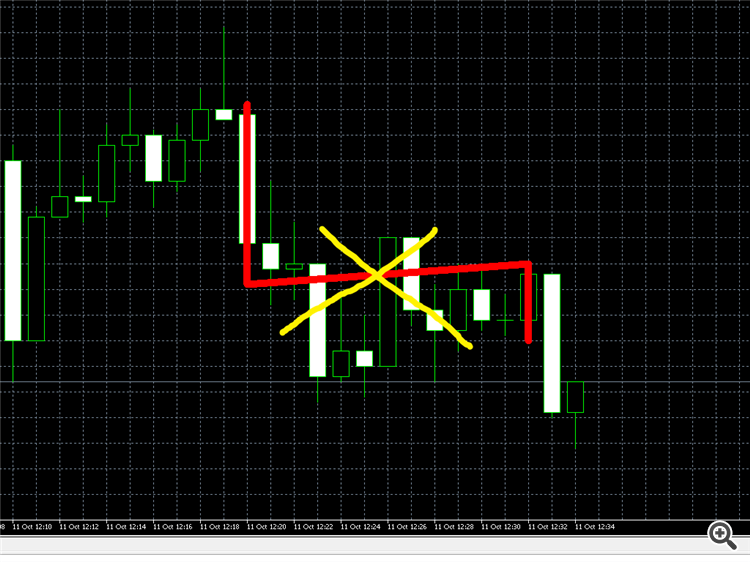선 대신 지그재그를 사용하면 작동합니다.
감사합니다. ZigZag를 파싱하고 선을 그리는 원리를 이해하려고 노력하겠습니다.
선 대신 지그재그를 사용하면 작동합니다.
지그재그 자체가 좀 복잡해서 파싱이 쉽지 않았다. 하지만 간단한 예를 준비했습니다... 마지막 막대에서 3개의 막대에 지그재그 조언에 따라 높음과 낮음 사이에 선이 있는 기능을 추가할 수 있습니까? 원리를 이해하고 나면 스스로 개발할 수 있습니다.
#property indicator_chart_window #property indicator_buffers 1 #property indicator_plots 1 //--- plot Support #property indicator_label1 "Line" #property indicator_type1 DRAW_LINE #property indicator_color1 clrAqua #property indicator_style1 STYLE_SOLID #property indicator_width1 3 //--- indicator buffers double LineTest[]; double HighMapBuffer[]; // highs double LowMapBuffer[]; // lows //+------------------------------------------------------------------+ //| Custom indicator initialization function | //+------------------------------------------------------------------+ int OnInit () { //--- indicator buffers mapping SetIndexBuffer ( 0 ,LineTest, INDICATOR_DATA ); SetIndexBuffer ( 1 ,HighMapBuffer, INDICATOR_CALCULATIONS ); SetIndexBuffer ( 2 ,LowMapBuffer, INDICATOR_CALCULATIONS ); PlotIndexSetDouble ( 0 , PLOT_EMPTY_VALUE , EMPTY_VALUE ); //--- return ( INIT_SUCCEEDED ); } //+------------------------------------------------------------------+ //| Custom indicator iteration function | //+------------------------------------------------------------------+ int OnCalculate ( const int rates_total, const int prev_calculated, const datetime &time[], const double &open[], const double &high[], const double &low[], const double &close[], const long &tick_volume[], const long &volume[], const int &spread[]) { //--- int limit=prev_calculated; for ( int i2=limit;i2<rates_total;i2++) // New bar recalculate { if (limit<rates_total- 1 ) continue ; // New bar recalculate for ( int i= 0 ;i<rates_total;i++) { //if(i<rates_total-3 && i>rates_total-15) // H Line 3-15 bar // LineTest[i]=high[rates_total-2]; // Price //else LineTest[i]=EMPTY_VALUE; HighMapBuffer[i]=high[rates_total- 3 ]; LowMapBuffer[i]=low[rates_total- 3 ]; LineTest[i]= // ??? } } return (rates_total); } //+------------------------------------------------------------------+
지그재그 자체가 좀 복잡해서 파싱이 쉽지 않았다. 하지만 간단한 예를 준비했습니다... 마지막 막대에서 3개의 막대에 지그재그 조언에 따라 높음과 낮음 사이에 선이 있는 기능을 추가할 수 있습니까? 원리를 이해하고 나면 스스로 개발할 수 있습니다.
https://www.mql5.com/ru/docs/customind/indicators_examples/draw_zigzag

- www.mql5.com
https://www.mql5.com/ru/docs/customind/indicators_examples/draw_zigzag
감사합니다. 여기에 이미 몇 가지 설명이 있으며 okozalos는 스타일이며 표시기가 아닙니다. :), 알아내려고 노력하겠습니다.
세로줄은 다 된것 같은데 세로줄 연결선 없애는 방법을 모르겠네요. 연결선이 사라지도록 누군가 내 예를 고칠 수 있습니까?
#property indicator_chart_window #property indicator_buffers 2 #property indicator_plots 1 //--- plot ZigZag #property indicator_label1 "ZigZag" #property indicator_type1 DRAW_ZIGZAG #property indicator_color1 clrRed #property indicator_style1 STYLE_SOLID #property indicator_width1 10 //--- indicator buffers double ZigZagBuffer1[]; double ZigZagBuffer2[]; //+------------------------------------------------------------------+ //| Custom indicator initialization function | //+------------------------------------------------------------------+ int OnInit () { SetIndexBuffer ( 0 ,ZigZagBuffer1, INDICATOR_DATA ); SetIndexBuffer ( 1 ,ZigZagBuffer2, INDICATOR_DATA ); return ( INIT_SUCCEEDED ); } //+------------------------------------------------------------------+ //| Custom indicator iteration function | //+------------------------------------------------------------------+ int OnCalculate ( const int rates_total, const int prev_calculated, const datetime &time[], const double &open[], const double &high[], const double &low[], const double &close[], const long &tick_volume[], const long &volume[], const int &spread[]) { int limit=prev_calculated; if (prev_calculated== 0 )limit=rates_total- 1 ; for ( int i2=limit;i2<rates_total;i2++) // recalculate on new bar { for ( int i= 0 ;i<rates_total;i++) { if (i==rates_total- 3 || i==rates_total- 15 ) // should be VLine on 3th and 15th bar! { ZigZagBuffer1[i]=high[i]; } else { ZigZagBuffer1[i]= EMPTY_VALUE ; } if (i==rates_total- 3 || i==rates_total- 15 ) // should be VLine on 3th and 15th bar ! { ZigZagBuffer2[i]=low[i]; } else { ZigZagBuffer2[i]= EMPTY_VALUE ; } if (ZigZagBuffer1[i]!= EMPTY_VALUE ) Print ( " ZigZagBuffer1[" ,i, "]: " ,ZigZagBuffer1[i]); if (ZigZagBuffer2[i]!= EMPTY_VALUE ) Print ( " ZigZagBuffer2[" ,i, "]: " ,ZigZagBuffer2[i]); } } return (rates_total); } //+------------------------------------------------------------------+
세로줄은 다 된것 같은데 세로줄 연결선 없애는 방법을 모르겠네요. 연결선이 사라지도록 누군가 내 예를 고칠 수 있습니까?
글쎄, 그럼 내가 틀렸어. 요점을 이해하지 못했다...
이 경우 그래픽 구성 DRAW_HISTOGRAM2 를 사용하는 것이 필요하고 더 쉽습니다.

- www.mql5.com

모든 것이 괜찮지 만 때로는 포인트의 시간이 하나의 촛불에있을 수 있으며 수직선이 나타납니다. 내가 알기로는 SupportBuffer[w]를 세로로 만들 수 없습니까?